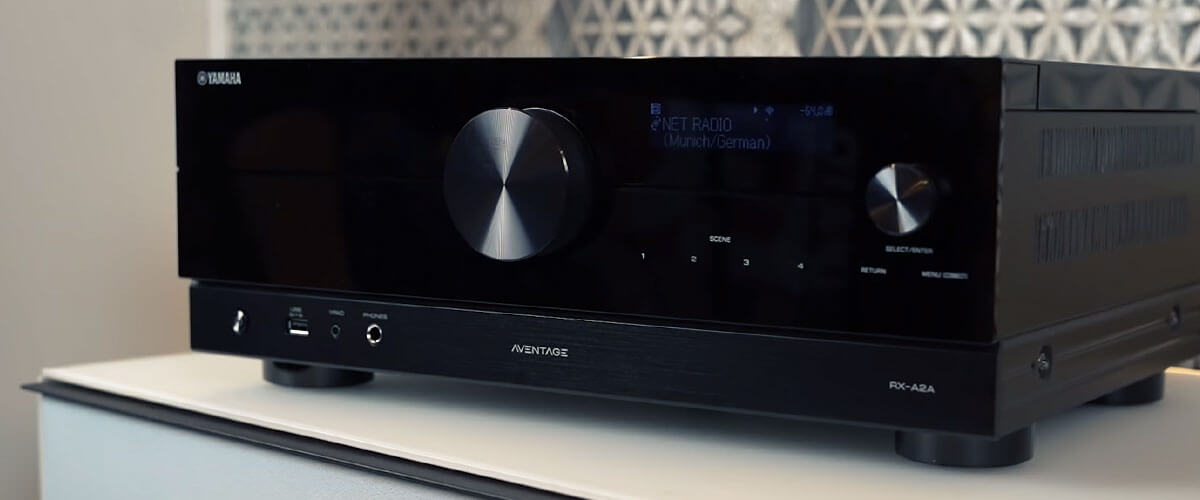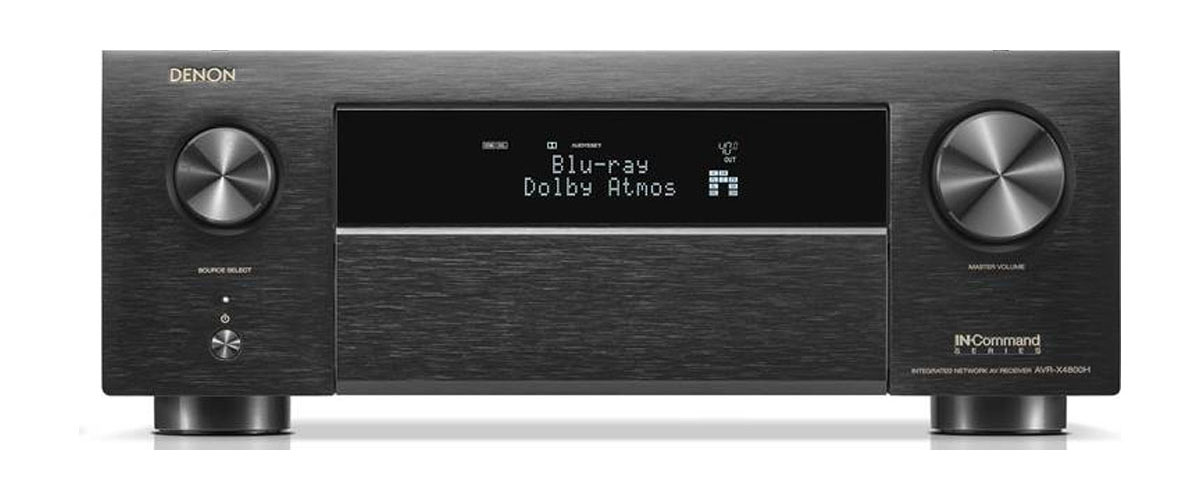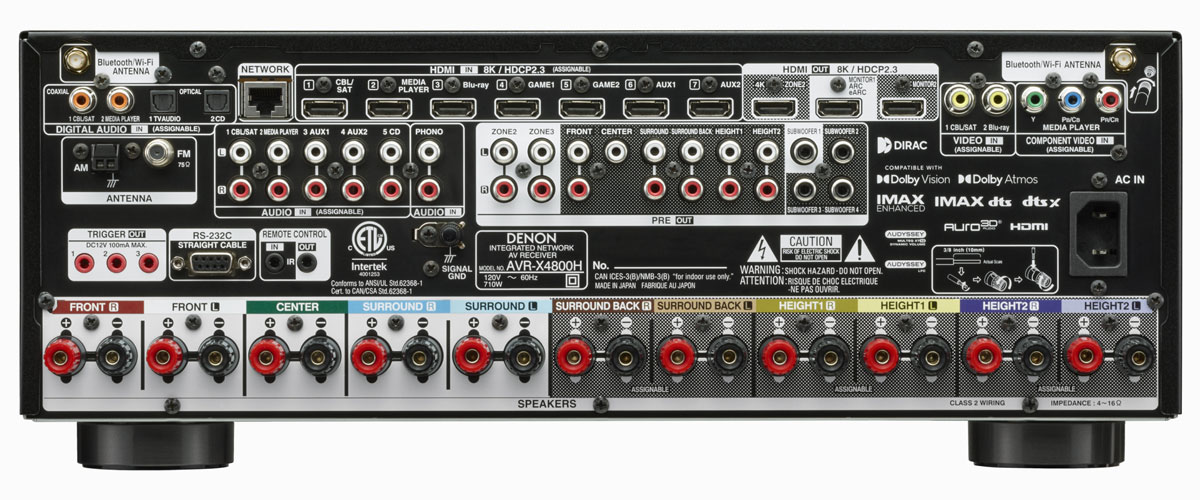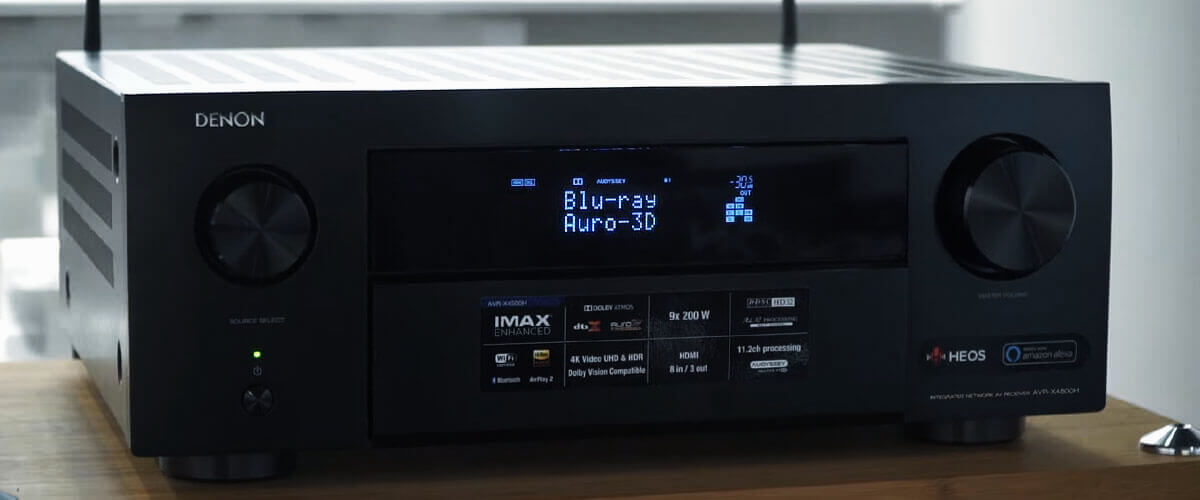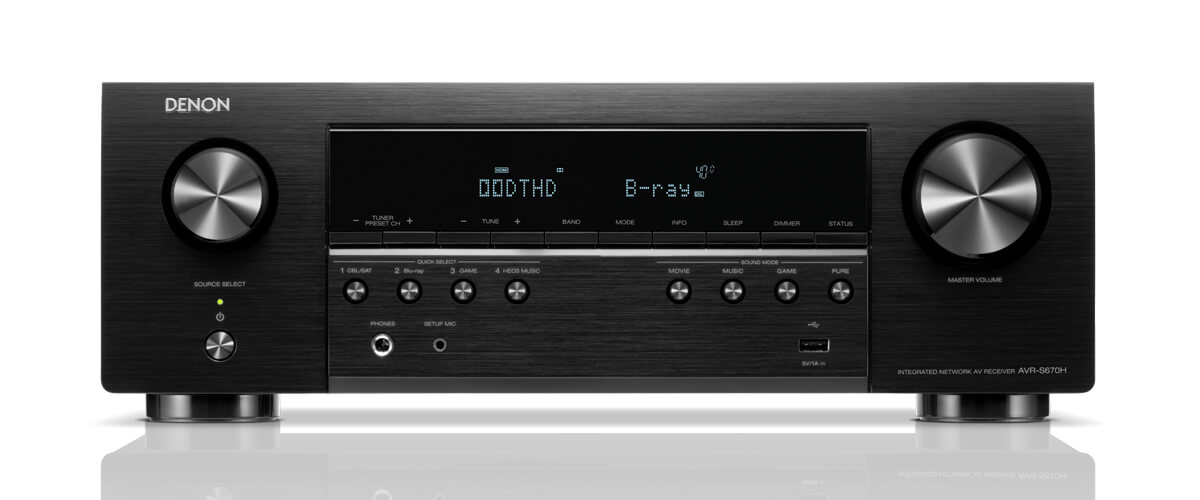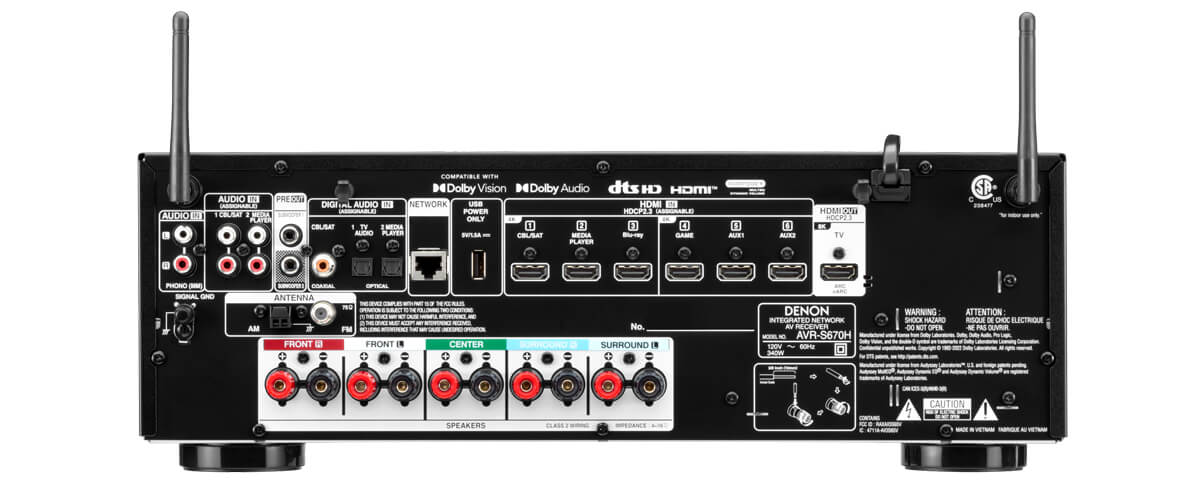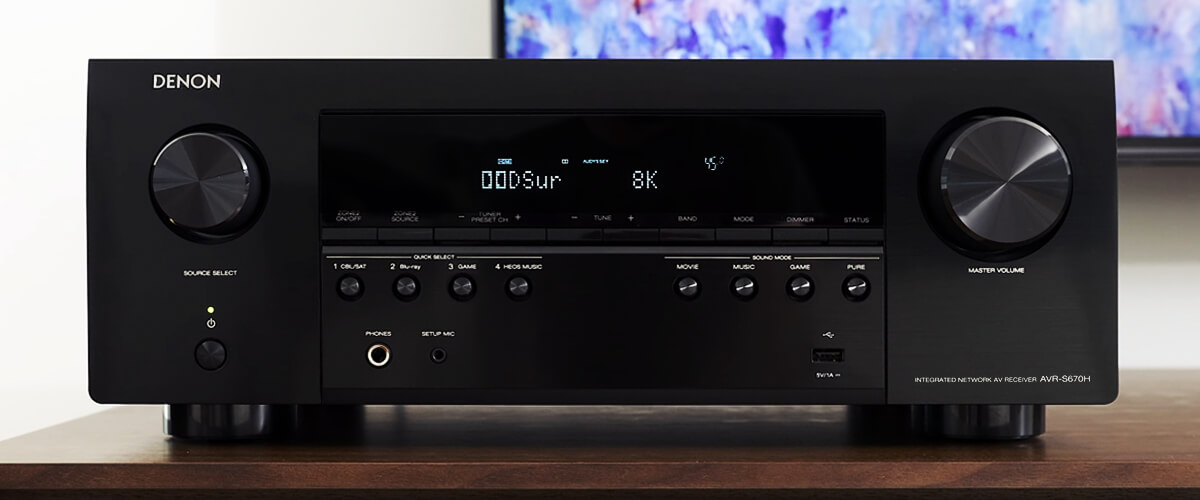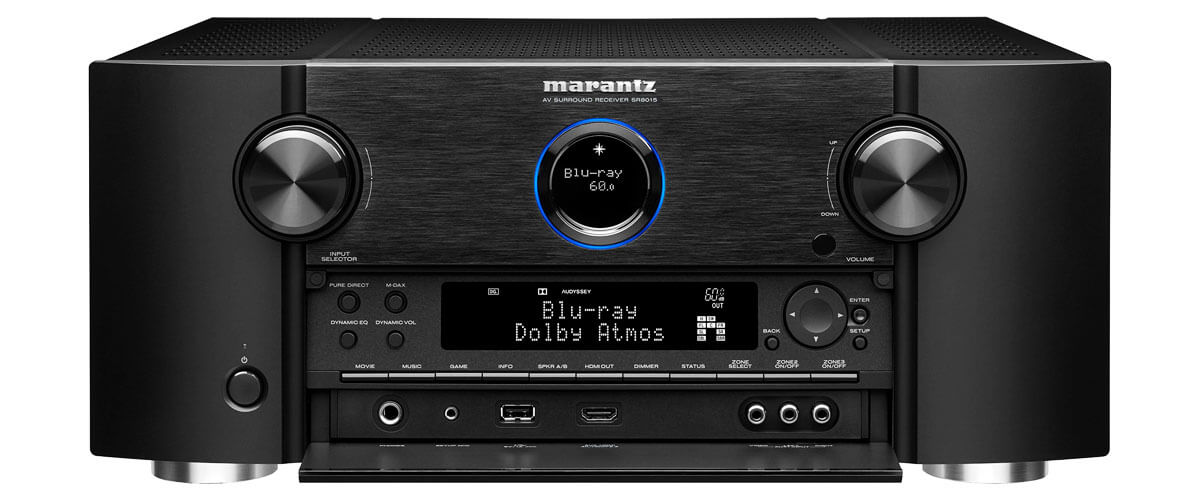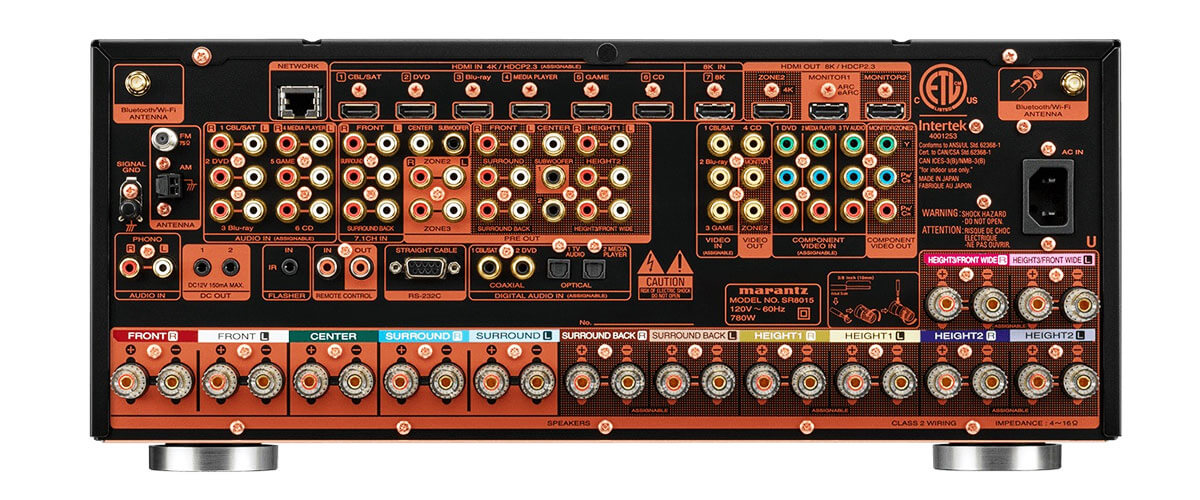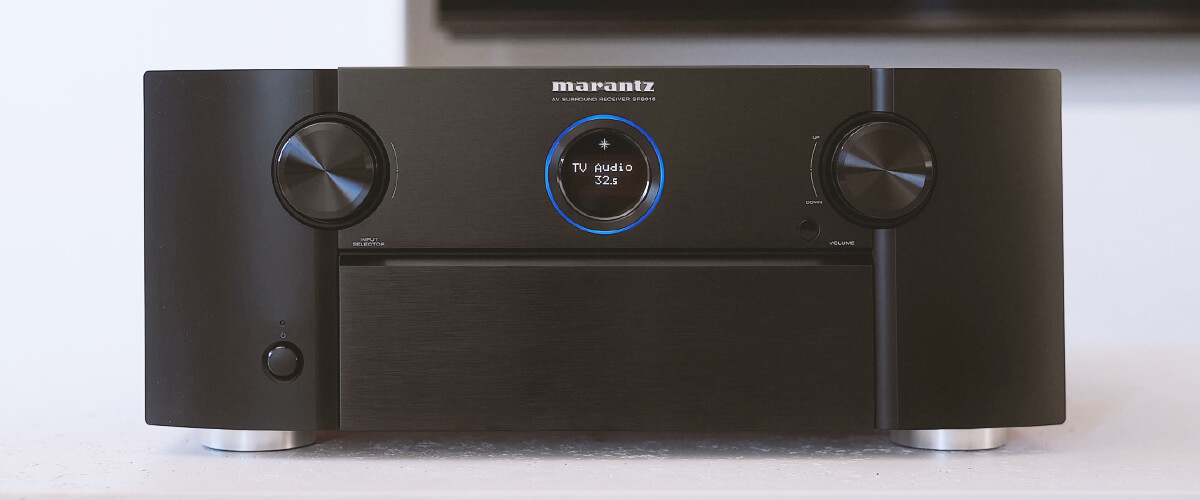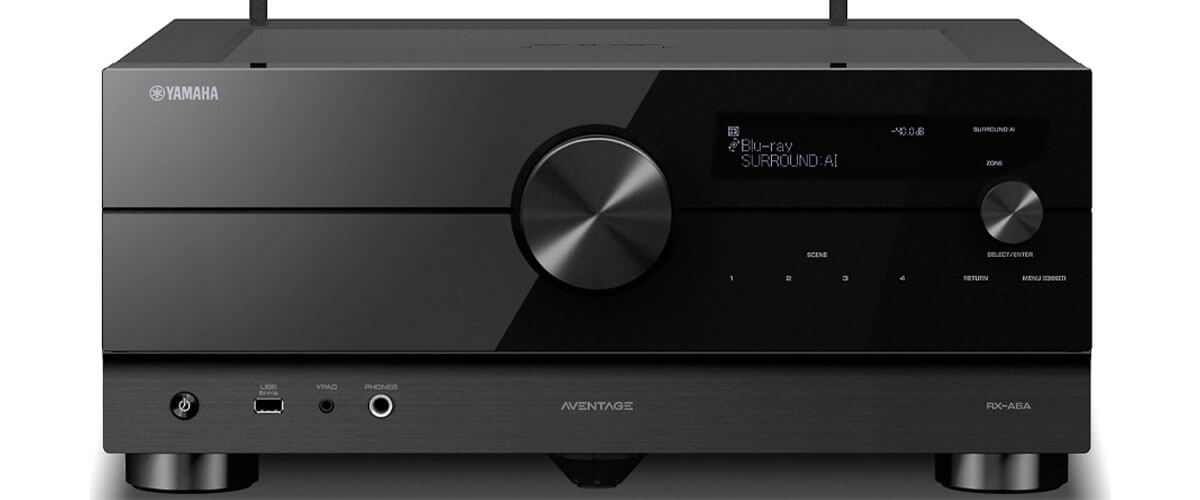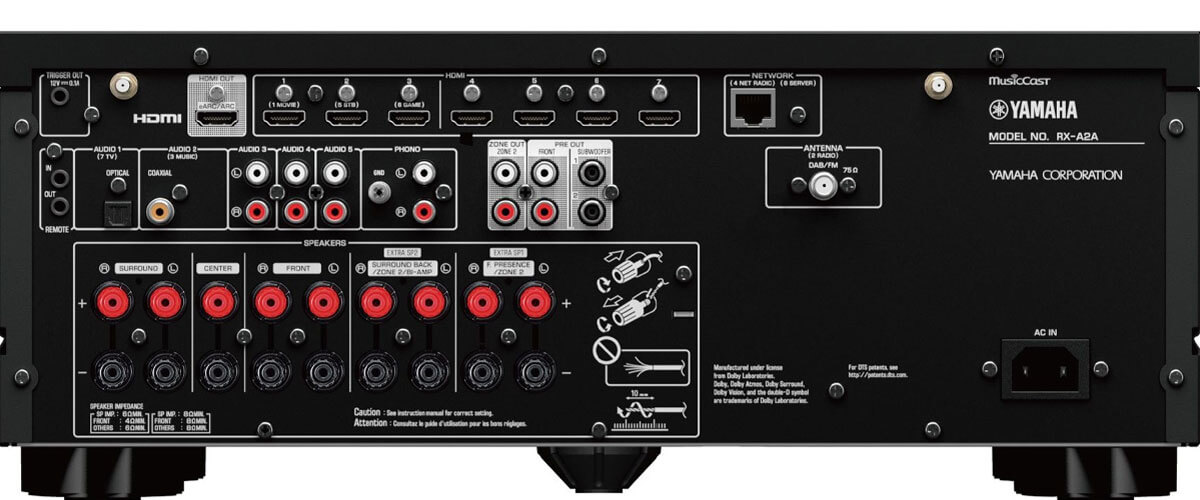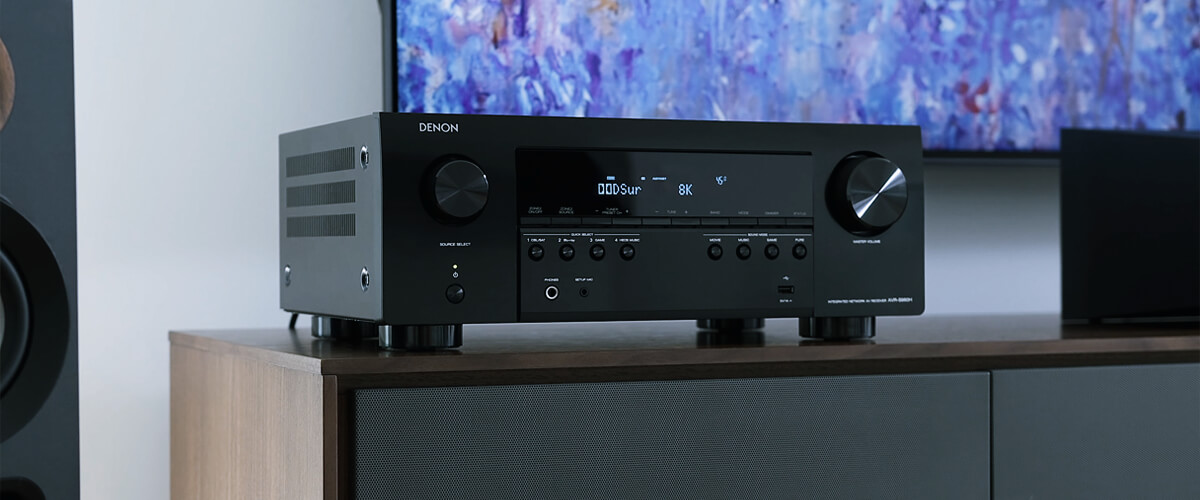8 Best AV Receivers For Music In 2024 - Homeowner.com After long research and testing, we’ve gathered our favorites and made the following selection of 8 best AV receivers for music in 2024. By Manny MayorWritten by Manny MayorAll Articles →Contributing Writer Updated on October 17, 2024 When buying an AV receiver for music, it is essential to consider factors such as sound quality, connectivity options, power output, channel configurations and features like Wi-Fi or Bluetooth. Here is an in-depth guide to help you make an informed decision when purchasing an AV receiver for music listening.

After long research and testing, we’ve gathered our favorites and made the following selection of 8 best AV receivers for music in 2024. By Manny MayorWritten by Manny MayorAll Articles →Contributing Writer
Updated on October 17, 2024
When buying an AV receiver for music, it is essential to consider factors such as sound quality, connectivity options, power output, channel configurations and features like Wi-Fi or Bluetooth. Here is an in-depth guide to help you make an informed decision when purchasing an AV receiver for music listening.
Well, looking for an AV receiver for music is not much different from looking for any AV receiver. After all, their primary purpose is to drive your surround sound system. Music reproduction is also important, but it’s still secondary. If you need the best possible amplification and audiophile-grade equipment for your high-end stereo speaker system, then you should probably think about buying a dedicated power amp and preamp. And maybe even a dedicated DAC. As far as AV receivers are concerned, you’re getting everything in one package (or in some cases – in two separate units).
So, the first thing to pay attention to is the number and type of inputs/outputs. As far as inputs are concerned, you need enough HDMI inputs to connect your video equipment and enough analog and digital audio inputs for your audio equipment. If you have a turntable, you should also look for an AV receiver with a phono stage.
When it comes to outputs, you should be looking for something that matches your speaker setup and gives you flexibility when it comes to upgrades. If you have a new TV, you should be looking for a receiver with HDMI ARC support. Some receivers also have dedicated outputs for one or two independent speaker pairs located in other rooms (multizone audio). Another thing that may come in handy are preamp outputs for all the channels (especially for the front left and right). If a receiver has those pre-outputs, you can buy a dedicated power amp in the future and run the interconnects from two of the receiver’s preamp outputs to the stereo amp and get a much better stereo performance when playing music.
Recommended Reading :
- 7 Best Center Channel Speakers
- 7 Best All-in-One Stereo Systems With Turntables
Finally, look for a receiver that has a high enough power output. And preferably, go for a receiver with a Class A/B amplification. Many affordable AV receivers have built-in Class-D amps (because Class-D amps are cheaper). Class A/B amps are less efficient than the Class-D amps but are better when it comes to sound fidelity and transparency. So, when looking for an AV receiver for music, you should pay a bit more attention to the sonic characteristics of the receiver.
If you’re interested in additional features, look for a receiver with Bluetooth and Wi-Fi connectivity, with internet radio, Alexa, Chromecast, or Airplay support, etc.
After long research and testing, we’ve gathered our favorites and made the following selection of 8 best AV receivers for music. We tried hard to make a comprehensive list and to include both – budget-friendly and high-end options. Hopefully, this list will help you find the perfect receiver for your setup.
8 Best AV Receivers for Music
1. Best Overall – Yamaha AVENTAGE CX-A5200 + Yamaha AVENTAGEMX-A5200BL
Check Price on Amazon
Having separate units for every purpose is the preferred way if you’re an audiophile. That’s why we decided to start our list of 8 best AV receivers for music in 2024 with a combo. It’s Yamaha’s CX-A5200 surround sound processor (AV preamp) paired with Yamaha’s MX-A5200BL multi-channel power amp. In this combo, the preamp is in charge of receiving and processing the signal, while the amplification is done by the separate unit (MX-A5200BL). This way, you will get a higher (and cleaner) power output, with much less noise, lower THD, and higher fidelity and sound transparency. It’s a perfect combo for both – surround sound and music reproduction.
Things we like
The preamp unit (CX-A5200) looks like a regular AV receiver with controls on the front and inputs/outputs on the back. The front panel looks exactly like the panel of some Yamaha Aventage AV receivers (RX-A1080, A2080, A3080). However, the big difference is that CX-A5200 doesn’t have any powered speaker outputs. Instead, it has 11 balanced XLR preamp outputs that connect to 11 XLR inputs on the MX-A5200BL. It also has 11 unbalanced RCA pre-outputs.
For sound optimization and calibration, you can use Yamaha’s famous YPAO calibration tool. It truly gives great results and makes a huge difference.
When it comes to inputs, you have 7 HDMI inputs and 3 outputs. All HDMI inputs support 4K UHD pass-through and 3D video. Furthermore, all 10 HDMI ports are compliant with HDCP 2.2 and support all the latest image standards (HDR10, HLG, Dolby Vision, BT.2021).
The unit also houses 4 composite video inputs, 2 component inputs, three coaxial, three optical audio inputs, 8 RCA inputs, and one phono input. On the front, you have a headphone output, RCA input, USB port, and YPAO mic connector.
As far as additional features are concerned, CX-A5200 features Bluetooth connectivity (V4.2 with AAC and SBC support) and dual-band wi-fi connectivity (2.4/5GHz). It also supports Airplay2 and features MusicCast. Thanks to MusicCast, the unit can be seamlessly integrated with other multiroom products (speakers, soundbars, and receivers) featuring MultiCast.
What guarantees great surround sound performance is the so-called Surround:AI processor built inside the DSP chip. This processor analyzes all the scenes in real-time and adjusts the sound reproduction constantly, creating a great sense of realism.
When it comes to music processing and digital-to-analog conversion, CX-A5200 features dual Sabre Pro Premier DAC chips (ES9026PRO) that enable 32bit/384kHz conversion. The unit can play FLAC, ALAC, WAV, AIFF, and DSD audio files (up to DSD256).
Yamaha AVENTAGE MX-A5200BL multi-channel power amp has a much cleaner look. On the front, there’s just the power button and A/B speaker selectors. On the back, there are 11 XLR balanced inputs, 11 unbalanced RCA inputs, and 11 speaker terminals arranged in two sections (R and L). The RMS power output with two 8Ω channels driven is rated at 150W (20Hz-20kHz, 0.06% THD). With bridged connection and two 8Ω loads, the RMS power output is rated at 200W (20Hz-20kHz, 0.06% THD).
Things we don’t like
The biggest downside could be the price. This combo will cost you more than $5,500.
Some users complained about the MusicCast app and the reliability of wireless streaming. However, we’ve had no problems with MusicCast.
2. Best Under $3,000 – Marantz AV Receiver SR8012
Check Price on Amazon
Marantz SR8012 is a highly versatile and very powerful AV receiver. Its transparent and clear sound output makes it the main reason why SR8012 is our favorite AV receiver for music under $3,000. SR8012 is an 11.2 receiver, compatible with Dolby Atmos and DTS:X. It has 11 HDMI ports (8 IN + 3 OUT), numerous analog and digital audio inputs, preamp outputs for all the channels, and 2 subwoofer pre-outputs. SR8012 is a perfect solution for your Dolby Atmos home theater system.
Things we like
SR8012 comes with a calibration mic, remote with an LCD display, radio antennas, detachable Bluetooth and wi-fi antennas, manual, and a warranty card.
To set the system up and calibrate the sound, you get to use the Audyssey MultEQ XT32 calibration tool and Audyssey MultEQ Editor App.
The controls are simple and intuitive. You can use the panel on the front side or the included remote. Or you can use the AVR remote app, which is not the most convenient way of controlling everything since it’s not very stable.
The receiver houses a multitude of inputs/outputs and most of them are on the back. When it comes to HDMI connections, you have 11 ports (7 HDMI IN on the back + 1 HDMI IN on the front + 3 HDMI OUT). One of those 3 HDMI outputs is HDMI ARC for connecting your TV. All these HDMI inputs/outputs are HDMI 2.0, they all support HDCP 2.2, and all the latest image standards including HDR10, Dolby Vision, HLG, and BT.2021.
Furthermore, you have plenty of other video/audio inputs – component video (3IN/1OUT), composite video (1IN/1OUT), optical audio inputs (x2), coaxial audio (x2), analog RCA audio inputs (x6), and one phono input. The unit also has an Ethernet port, radio antenna inputs, Bluetooth/wi-fi antenna input.
SR8012 has 11 speaker outputs (5-way binding posts). It also has two subwoofer pre-outputs as well as pre-outputs for all the other channels in case you want to connect an external power amplifier to the unit. This number of speaker terminals allows you to have a full Dolby Atmos speaker system (something like 7.2.4 or 9.2.2). According to the manual, the unit pushes 140W per channel when two 8Ω channels are driven (0.05% THD) or 175W per channel when two 6Ω channels are driven (0.7% THD). The unit is compatible with 4-16Ω speakers.
Aside from the standard features, Marantz SR8012 features Bluetooth connectivity and dual-band wi-fi connectivity. The device is Roon-tested. It supports Airplay 2 and is compatible with all voice assistants. SR8012 features multi-zone capabilities and is compatible with HEOS wireless speakers.
The unit supports all Dolby and DTS surround sound audio formats including DTS:X and Dolby Atmos.
Things we don’t like
The AVR remote app needs serious polishing. The biggest complaint people had about this app is related to the app stability.
The Bluetooth version is outdated (BT 3.0 + EDR) and none of the advanced Bluetooth codecs (aptX or LDAC) are supported (only SBC).
3. Best Under $4,000 – Denon AVR-X8500HSP
Check Price on Amazon
As Denon and Marantz are part of the same company, AVR-X8500HSP has a very similar set of features like the previously reviewed Marantz AV receiver. They even have a similar design. However, Denon AVR-X8500HSP is more versatile, it has more speaker terminals (13 VS 11), and slightly higher power output.
Things we like
Like the Marantz receiver, AVR-X8500HSP comes with remote, calibration mic, radio antennas, detachable Bluetooth and wi-fi antennas, manual, and a warranty card.
To calibrate the system, like in the case of SR8012, you will have to use the included mic, Audyssey MultEQ XT32 calibration software, and Audyssey MultiEQ Editor app.
When it comes to controls, you can use the control panel on the front side (most of the controls are located behind the hidden compartment) or the remote. Also, you can use the Denon AVR remote app.
The most special thing about AVR-X8500HSP is its connectivity. Aside from 8 HDMI inputs (7 on the back + 1 on the front) and 3 HDMI outs (one HDMI eARC), you have plenty of video inputs and outputs (composite – 4 IN and 1 OUT, component – 3IN and 1 OUT) as well as analog and digital audio inputs (RCA IN x6, optical x2, coaxial x2, and one phono input). On the front, you also have one USB input, one 3.5mm input, and a mic input for calibration.
All HDMI ports are HDMI 2.0 with HDCP 2.2 support. They all support 4K/60Hz pass-thru and all the latest image standards (HDR10, Dolby Vision, HLG).
The unit has 15 speaker terminals. 13 speaker outputs are powered. It also has two subwoofer pre-outputs and preamp outputs for all the other channels. It can push 150W of power (two 8Ω channels driver, 0.05% THD) or 190W of power (two 6Ω channels, 0.7% THD). The max supported speaker layouts are 9.2.4 or 7.2.6.
The unit has built-in AKM’s 32bit converters. It supports all the most popular lossless audio formats (FLAC, ALAC, WAV) and can play in hi-res files up to 24bit/192kHz. It also supports DSD64 and DSD128.
AVR-X8500HSP features Bluetooth connectivity and dual-band wi-fi connectivity. It supports the multi-zone feature (two separate zones) and multiroom functionality thanks to its compatibility with wireless HEOS speakers.
All Dolby and DTS formats are supported, including object-based DTS:X and Dolby Atmos.
Things we don’t like
AVR-X8500HSP has absolutely the same downsides as the previous Marantz SR8012 receiver – outdated Bluetooth version with only SBC support and poor Denon AVR remote app.
4. Best 7.2 AV Receiver Under $2,000 – Lexicon RV6
Lexicon RV6 by Harman Kardon is a bit more affordable option than the previous two receivers, but it’s also slightly less versatile and supports smaller speaker layouts.
Things we like
Lexicon RV6 comes with a calibration mic, remote (with batteries), FM/DAB antenna, manual, and a warranty card.
During the initial setup, you will have to use the included mic and Dirac Live room correction software to calibrate the sound. You just have to install the software and follow the on-screen instructions.
On the front panel, there are some basic controls, a simple LCD display, headphone output, and mic input. The rest of the inputs are on the back. The unit has 10 HDMI ports (7 IN and 3 OUT). One of the outputs is the HDMI ARC. All the HDMI ports are HDMI 2.0a with HDCP 2.2 support and 4K UHD pass-thru. RV6 also has 4 coax inputs, 2 optical inputs, and 6 analog RCA inputs. Furthermore, you have one USB input, DAB/FM antenna input, and Ethernet port.
RV6 has 7 powered speaker terminals, two subwoofer outputs, as well as 11 preamp outputs, which allow you to expand the system from 5.1.2 (or 5.2.2) to 7.2.4. However, that would require an additional multi-channel amp. The unit also supports the multizone feature (but you have to sacrifice your height speakers).
According to the specs, the unit can push 110W continuously into two 8Ω loads (20Hz-20kHz, 0.02% THD) or 90W into seven 8Ω channels (at 1kHz, 0.2% THD). It has a Class-A/B amp built inside.
RV6 has a built-in high-quality 24bit/192kHz DAC by Cirrus Logic. It supports hi-res playback of lossless files (FLAC and WAV).
Lexicon AV control app comes with the unit and allows you to control all the basic and some advanced playback parameters.
The unit can decode all the popular surround sound formats including Dolby Atmos and DTS:X.
Things we don’t like
RV6 lacks some advanced features you can find on other similarly priced AV receivers. For example, it doesn’t feature Bluetooth or wi-fi connectivity. It also doesn’t have any phono inputs or additional video inputs other than HDMI.
5. Best Under $1,500 – NAD T 758 v3
Check Price on Amazon
NAD T 758 is not incredibly versatile but it still packs some great features and is an excellent choice for music. T 758 v3 is our top choice when it comes to AV receivers for music under $1,500.
Things we like
T 758 v3 comes with a remote (batteries included), calibration mic, power cable, and user manual.
The unit is quite robust. The control and input/output schemes are very intuitive. The whole design is quite clean. On the front, you have some basic controls and a hidden compartment with 4 inputs (RCA x1, composite video IN x1, optical audio IN x1, and mic input).
On the back, you will find 3 HDMI inputs and one HDMI ARC output. They are all HDPC 2.2 compliant and support 4K UHD pass-through. Aside from HDMI inputs, you have one USB port, two coax audio inputs, two optical audio inputs, four RCA inputs. There’s also a set of 7.1 analog inputs. The unit has 7speaker terminals as well as 7 preamp outputs and one subwoofer pre-output. The power output is rated at 110W (two 8Ω channels driven, 0.08% THD).
For the initial setup and sound calibration, you get to use the included Dirac Live room correction.
To control the unit, you can use the remote or the NAD AV remote app.
The unit uses the latest Gen of multi-core DSP chips that support hi-res audio playback and MQA. It also has a built-in BluOS wireless streaming technology that allows you to stream lossless audio wirelessly and to combine the receiver with BluOS wireless speakers and make a multiroom speaker system.
Things we don’t like
NAD T 758 v3 is not as versatile as some pricier units – it has only 3 HDMI inputs. Also, it doesn’t feature Bluetooth or wi-fi connectivity, and it doesn’t support Airplay2.
NAD AV remote app is quite unstable and unreliable.
6. Best Under $1000 – Denon AVR-X3600H
Check Price on Amazon
Denon AVR-X3600H is an amazing AV receiver with so many features and a very reasonable price. You can hardly find a more versatile and better-performing AV receiver at this price point.
Things we like
AVR-X3600H comes with a calibration microphone, remote, power cable, and user manual.
During the initial setup, you can use the MultEQ XT32 calibration tool (the same one that comes with much pricier Denon receivers).
On the front, you have some basic controls and a couple of I/O (headphone OUT, mic IN, one HDMI IN, and a USB port).
On the back, you have 7 more HDMI inputs and 3 outputs. All HDMI inputs are HDCP 2.3 compliant and they all support 4K/60Hz and all the latest image standards (Dolby Vision, HDR10, HLG).
The receiver also has numerous video and audio connections – component video (2IN, 1OUT), composite video (3IN), optical audio (2IN), coaxial audio (2IN), RCA audio (5IN), and one phono input.
Furthermore, the receiver has 11 speaker outputs, 9 of which are powered. So, without any additional equipment, you can make a 5.1.4 or 5.2.4 surround sound system. With an additional stereo amp for the Zone 2, you can run 11 channels simultaneously. The receiver also has dual subwoofer pre-outputs as well as 11 additional preamp outputs for all the available channels. The power output is rated at 105W (two 8Ω channels driven, 20Hz-20kHz, 0.08% THD).
For the audio signal conversion, AVR-X3600H uses AKM’s 32bit DAC chips on all channels. It supports FLAC, ALAC, and WAV (up to 24bit/192kHz) as well as DSD128. That’s one of the main reasons why we consider X3600H one of the best AV receivers for music under $1000.
The receiver is also packed with all kinds of additional features like Bluetooth and wi-fi (dual-band) connectivity. It also features multizone capabilities. Thanks to Denon’s HEOS technology, the receiver is also compatible with other HEOS wireless speakers (multiroom capabilities). Finally, the receiver is compatible with all the popular voice assistants including Alexa, Siri, and Google Assistant.
Things we don’t like
Denon AVR remote app is one of the ways of controlling the receiver and wireless streaming but it’s not very stable.
7. Pioneer Elite VSX-LX505 Elite 11.2
Check Price on Amazon
Kicking off our exploration of noteworthy AV receivers is Pioneer’s offering: the Elite VSX-LX505. Distinguished in its design, this receiver masterfully combines the roles of signal reception, processing, and amplification, ensuring immaculate sound delivery. Owing to its high-fidelity performance and minimized noise, it merits consideration as a top-tier choice for both surround sound and music reproduction.
Things we like
The Elite VSX-LX505 exudes the timeless aesthetic charm characteristic of Pioneer, with a sleek front panel similar to many AV receivers on the market. Yet, the remarkable difference lies within. Rather than built-in speaker outputs, it boasts 11.2 channels pre-out connectivity, with both balanced XLR and RCA pre-outs to facilitate seamless connection with separate power amps or active speakers.
In terms of calibration, the VSX-LX505 comes equipped with Pioneer’s MCACC Pro room calibration technology. This intuitive tool works wonders in optimizing sound to the specifics of your listening space, making a significant difference in the overall audio experience.
Connectivity options are generous with 6 HDMI inputs and 2 outputs, all supporting 4K UHD, HDCP 2.2, HDR10, Dolby Vision, and BT.2021. For audio, there are 2 coaxial and 2 optical inputs, 6 analog audio inputs, and a Phono input for vinyl lovers. Additionally, a USB port graces the front panel for easy access.
As for wireless connections, the Elite VSX-LX505 supports Bluetooth and dual-band Wi-Fi. It’s also compatible with Apple AirPlay 2 and Pioneer’s FlareConnect for a multi-room audio experience.
Inside the unit, Pioneer’s innovative Surround:AI technology shines. This real-time processing engine analyzes every scene and continuously adjusts sound output to deliver a stunningly realistic and immersive audio experience.
For music processing, the unit houses an advanced 384 kHz/32-bit DAC (Digital-to-Analog Converter), capable of handling Hi-Res audio formats including DSD, FLAC, ALAC, WAV, and AIFF for optimal sound quality.
Things we don’t like
The Elite VSX-LX505 does carry a relatively high price tag, and its premium features might be more than a casual listener requires. However, for those seeking a superior audio experience, it is undoubtedly a worthwhile investment.
Additionally, while Pioneer’s FlareConnect technology promises a seamless multi-room experience, some users have reported intermittent connectivity issues during wireless streaming. Despite these isolated incidents, our experience with FlareConnect was smooth, presenting no significant issues.
8. Yamaha RX-A6A Aventage
Check Price on Amazon
Another high-end AV receiver is this standout from Yamaha – the RX-A6A Aventage. This receiver blends meticulous craftsmanship with innovative technology, delivering an impeccable audio-visual experience. Its superior performance and immersive audio reproduction make it an attractive choice for the discerning audiophile.
Things we like
The RX-A6A Aventage, staying true to Yamaha’s minimalist design philosophy, exhibits a robust front panel similar to other models in the Aventage lineup. Its key distinction lies in the internal structure. The RX-A6A is designed around Yamaha’s concept of ‘Total Purity’, integrating a symmetrical power amplifier layout and rigid chassis for enhanced audio quality.
When it comes to calibration, the RX-A6A uses Yamaha’s proprietary YPAO (Yamaha Parametric room Acoustic Optimizer) technology. This smart tool works to tailor the sound output to the specifics of your listening room, resulting in a finely-tuned audio experience.
The RX-A6A features an abundance of connectivity options, including 7 HDMI inputs and 3 outputs, all supporting 8K/60B and 4K/120Hz. These HDMI ports also support the latest HDR formats including HDR10+, HLG, and Dolby Vision. For audio connectivity, it includes digital coaxial, optical inputs, and an array of analog inputs, along with a phono input for turntables.
Wireless connectivity is catered to with both Bluetooth and Wi-Fi. AirPlay 2 is supported for Apple users, and Yamaha’s MusicCast allows for an effortless multi-room audio setup.
One key highlight of the RX-A6A is Yamaha’s AI-driven Surround:AI technology. This dynamic feature analyzes each scene in real-time, adjusting sound parameters for optimum performance. The result? A truly immersive soundstage, with a realism that keeps you at the edge of your seat.
For music enthusiasts, the RX-A6A doesn’t disappoint. The receiver houses an advanced ESS SABRE PRO Premier DAC (ES9026PRO), offering a super-high “measured 124dB signal-to-noise ratio”. This ensures top-tier sound reproduction, handling Hi-Res audio formats including DSD, FLAC, ALAC, WAV, and AIFF.
Things we don’t like
Much like its high-end counterparts, the RX-A6A Aventage doesn’t come cheap. Its price reflects its premium offerings and might be considered excessive by the casual listener. However, for the audiophile seeking stellar performance, this receiver is unquestionably a worthwhile investment.
Additionally, some users have reported occasional instability with MusicCast multi-room setups. Nonetheless, these instances are rare, and our interaction with the MusicCast system remained largely uninterrupted.
Things to Look Out For in a Good AV Receiver
Now we explore the key factors to consider when selecting a good AV receiver. From sound quality to connectivity options, we will discuss the essential features that make an AV receiver suitable for delivering a great audio experience.
An Audio-Video (AV) receiver acts as the central hub for your home entertainment system, handling audio processing and video pass-through. If you’re in the market for one, here are some essential factors to consider:
1. Number of Channels
The number of channels in an AV receiver determines how many speakers it can support. If you plan to set up a simple stereo or a 5.1 surround sound system, a receiver with five channels will suffice. But if you aim for a 7.1, 9.2, or even an 11.2 Dolby Atmos setup, ensure the receiver has enough channels to accommodate.
2. Power Output
The power output of an AV receiver, measured in watts, signifies how loud the system can get. More power can provide better sound quality at higher volumes, but remember that very high-power receivers may require compatible, high-quality speakers to perform optimally.
3. HDMI Inputs
The number of HDMI inputs is crucial because it determines how many devices (like gaming consoles, Blu-ray players, or streaming devices) you can connect to the receiver. Always look for a receiver that has more HDMI inputs than you currently need. It will help accommodate future upgrades.
4. Support for Latest Audio and Video Formats
Your AV receiver should be capable of decoding the latest audio formats like Dolby Atmos and DTS:X. Also, look for video support for 4K, HDR, and HDMI 2.1, which are becoming standard in modern home entertainment.
5. Network Connectivity
Modern AV receivers often come with network connectivity options, like Wi-Fi and Ethernet. This feature allows for network streaming and integration with your smart home devices.
6. Calibration System
A good AV receiver will include an automatic speaker calibration system. This feature adjusts the sound output based on the specific acoustics of your room, ensuring the best possible sound quality.
7. User Interface:
The receiver should have an easy-to-understand and navigate user interface. This will make setup and daily operation a breeze.
8. Brand Reputation and Reviews
Lastly, look into the brand’s reputation and customer reviews. Brands with a history of quality products and strong customer support are often safer bets. Reviews can provide insights into real-world performance and potential issues.
FAQs
Q:What is the best AV receiver for music in 2024?A: There are so many great AV receivers with all kinds of features, connections, and power outputs. The price also varies a lot. All these things make it practically impossible to select just one receiver. That’s one of the reasons we made our list of best 8 AV receivers for music in 2024. Check it out and find a receiver that meets your requirements and fits the budget.
Q:Who makes the most reliable AV receivers?A: Well, there are a few names that come to mind. Some of the most reputable brands when it comes to receivers are Marantz, Pioneer, Denon, Onkyo, Yamaha, Arcam, NAD, etc. The first four brands (+ Integra) are now part of the same audio company called Sound United and they often share technologies, so you can usually find the same (or at least similar) features on similarly priced AV receivers coming from these manufacturers.
Q:Do AV receivers affect audio quality?A: AV receivers have a crucial effect on the audio quality. After all, they are responsible for receiving the signal from all the sources, for all the audio signal processing, for converting all the digital signals to analog, and finally, they are responsible for the amplification. All those things determine the quality of the sound. So, yeah, AV receivers are very important for the audio quality.
Q:Which is better Marantz or Denon?A: As discussed in one of the previous answers, Marantz and Denon are now part of the same company and use the same technological solutions (like auto-calibration tools, apps, etc.). The same-priced receivers from Denon and Marantz have similar features and number of connections but there are some subtle differences in sound reproduction – Denon is a bit brighter while the Marantz receivers sound warmer. In the end, it all depends on your taste in sound.
Q:How do I choose an AV receiver?A: We have discussed this in the introduction, so here’s a short recap. First, set your budget limits. Second, determine how many HDMI and other inputs you need to connect all the existing and maybe some future sources you want to buy. Third, look for the receiver with enough speaker outputs for all the home theater speakers you want to connect and check if it has enough power to drive all the speakers. Finally, look for additional features you find important (Bluetooth, wi-fi, app, Chromecast, Airplay, internet radio, etc.).
Q:Do expensive AV receivers sound better?A: In general, the answer is yes. Pricier receivers enable cleaner signal processing, have higher power output and sound better. However, the quality of the sources and of the original audio coming to your receiver, as well as the quality of the speakers, are also very important. Having poor-quality speakers connected to a high-end AV receiver is absolutely meaningless.
Q:Can I use an AV receiver as a power amp?A: Yes. An AV receiver can be used as a power amp. One of the purposes of a receiver is to amplify the audio signal and send it to speakers, just like a power amp.
Was this article helpful?YesNoThanks for your feedback!
Contributing Writer
212 Posts
Is a Receiver the Same as an Amplifier? Receivers vs Amplifiers
9 mins read 9 mins read
Dolby Atmos vs Dolby Digital For Your Home Theater
5 mins read 5 mins read
Do You Need a Preamp for a Home Theater?
8 mins read 8 mins read
Does a Receiver Need to Support HDR?
7 mins read 7 mins read
Are AV Receivers Good For Music?
7 mins read 7 mins read
2024 Best Bluetooth Audio Receiver + Setup Guide
7 mins read 7 mins read
What Does a Speaker Switch Do?
9 mins read 9 mins read
Yamaha WXA-50 vs. WXC-50: What’s the Difference?
9 mins read 9 mins read
FAQ
What is a 4K AV receiver?
A 4K receiver, also referred to as an AV receiver (Audio-Visual receiver), acts as the central hub of your home theater system. Its primary function is to process audio and video signals from various sources, such as gaming consoles, Blu-ray players, streaming devices, and cable/satellite boxes.Nov 20, 2023
What is AV in an amplifier?
It is expensive because it’s a big chunk of the budget, but there’s a lot”, says Damian. “As you know yourself, first the equipment costs, right? Actually owning the equipment yourself, as in the AV company, owning the equipment or hiring it from another AV company costs.
What is AV in cinema?
An audiovisual work (AV work) is a series of related images that are capable of being shown by some device, along with any sounds that accompany the visual portion of the work. The audiovisual works category includes movies and films, as well as slide shows, video games, and the like.
What is AV in amplifier?
An AV (Audio-Visual) receiver is a central hub for your home entertainment system, designed to enhance and streamline the audio and video experience. It serves as the heart of your home theater setup, connecting various audio and video sources to your speakers and TV or projector.14 июн. 2024 г.
Who is the famous actress in Japan?
Nanase Nishino was born on 25 May 1994 in Osaka, Japan. She is an actress, known for The Blood of Wolves II (2021), Shin Kamen Rider (2023) and XxxHolic (2022).














